
| NHRA
at Chicago By Susan Wade Photos by Jeff Burk 5/25/04 |
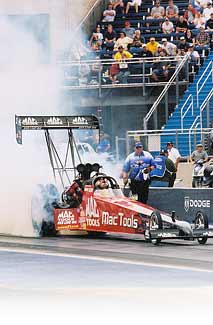 Heartland
Park Topeka has a tough act to follow, after NHRA accented the “go”
in Chicago.
Heartland
Park Topeka has a tough act to follow, after NHRA accented the “go”
in Chicago.
Despite daily thunderstorms and tornado scares, Route 66 Raceway showed off its glassy perfection May 21-23 for the eighth stop in the NHRA Powerade Drag Racing Series. No fewer than five nitro-class drivers set superlatives as they spent the weekend outshining each other and rewriting national records.
However, the unfortunately unsponsored Route 66 Nationals was not without its soap-opera scenarios of vindication, threats made good, wild car rides, near catastrophies, sickening fraction-of-a-second mistakes and at least one sarcastic jab at NHRA policy.
Doug Kalitta put an exclamation mark on the event with his $40,000 Top Fuel victory over Brandon Bernstein. He said against Bernstein and the Budweiser/Lucas Oil Dragster “you have to make sure you have something to get by him.” Kalitta most certainly did. He drove the Mac Tools Dragster to a stunning 4.420-second elapsed time at 328.22 miles an hour.
It registered as the quickest lap in Top Fuel history, but he did not back it up within the required one percent. He missed the accomplishment by one-thousandth of a second. Still, he defended NHRA’s back-up rule: “It’s been there forever. It has some merit. My vote would be to keep it.”
One can only imagine what Kalitta could have clocked had he not experienced some glitches. “I was just about to the finish line and I threw the (blower) belt off,” he said.
Doug said that Rahn Tobler, who helped wife Shirley Muldowney to three titles, has provided consistency as his new crew chief. “He adds another dimension. He brings consistency to our tune-up and doesn’t always swing for the fence.”
In that final round, Bernstein was doing just that. Kenny Bernstein said that he and crew chief Tim Richards decided to “put a lot of horsepower into the car because we knew it was going to be a tough match.”
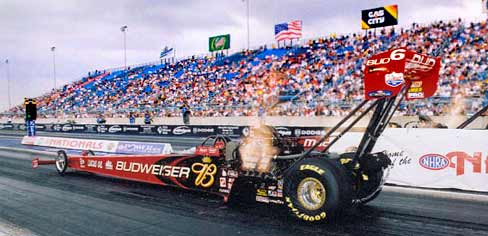
Brandon Bernstein was not going to coast after setting the national speed record at 333.41 mph in the first round and backing up the run up in the semifinals at 332.26. He is now known as the “Prince of Speed.”
But the sophomore Top Fuel driver was too busy trying to tame his unruly car
to offer Kalitta a response any better than 5.283 seconds at 182.08 mph. The
famous red car, which had carried both father and son to victory in six of the
previous 11 races, launched stubbornly, then did a wheelstand at about half-track.
“It left extremely hard,” Bernstein said. “It was marching along and it set the front end down, and when it really started to pour it to it. It (the front end) picked it up so fast, it just kept going. It wasn’t going to go down. There wasn’t anything I could do but lift.
Fuel Coupe Action:
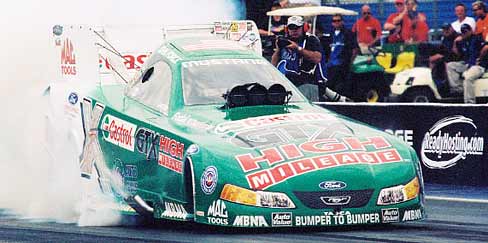
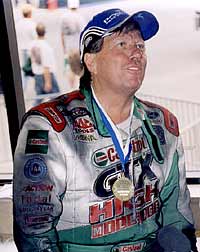 Gary
Scelzi, Tony Pedregon and Whit Bazemore were busy trumping each other with milestones
and records while John Force swiped the $40,000 Funny Car prize. He said their
eye-popping numbers “gave us something to chase so we could get our Ford
back into the winner’s circle.”
Gary
Scelzi, Tony Pedregon and Whit Bazemore were busy trumping each other with milestones
and records while John Force swiped the $40,000 Funny Car prize. He said their
eye-popping numbers “gave us something to chase so we could get our Ford
back into the winner’s circle.”
The dethroned 12-time champion, who has struggled from eighth place in the standings to second, said, “I’ll never take a win for granted again.” Just the same, he earned his second victory in three races and his 111th overall.
Force almost didn’t make it to, let alone past, the second round. A mechanical problem in the pits nearly caused him to miss the match-up with his former protégé, their second pairing since Pedregon chose to form his own team. Force took his Mustang to the starting line on life support, with a bent intake valve and a flawed ignition system.
He left the starting line, then, at crew chief Austin Coil’s direction, shut off the motor. “You can’t have it go up there and blow up and kill everybody,” Force said. Co-crew chief Bernie Fedderly focused on a magneto switch, and, Force said, “It fired up. Amazing. I said, ‘Lord, now you just want to kill me!’” Pedregon, unaware of the extent of Force’s problems, briefly lost control at mid-track, crossed the center line and was disqualified. Force said that he thought the crosswind probably caught Pedregon but called the result divine intervention.
He defended his run against Medlen. “No, Eric did not lay down,”
Force said emphatically. “If people don’t like it, I don’t care.
My hunk of junk just came alive.”
And it was just in time to yank the rug from under Bazemore, whom he also beat in the Bristol final. Force said that he and his brain trust decided not to pursue a record with the ideal combination of a slick track and cool temperatures. He said instead, they targeted the victory and its $40,000 payoff.
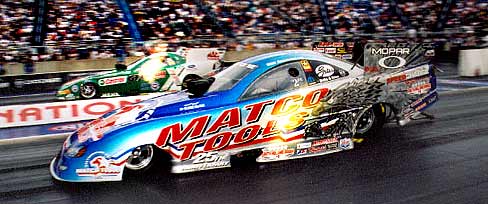
Bazemore, in the Matco Tools Dodge Stratus, earned the national e.t. record with a 4.713-second pass in a no-contest victory over Tony Bartone. His 333.25-mph speed was fastest in NHRA Funny Car history, but he did not back it up within the required one percent in the final. His run overrode Pedregon’s top-qualifying effort of 4.716/331.28.
That blast guaranteed he would overtake Del Worsham for the Funny Car points lead. Bazemore came into the Chicago fall race last year as the points leader for the first time in his career but lost it there, so he had a measure of redemption there. But the promise that he also could own the national speed mark, if he posted a 329.92 mph next, supercharged his final-round meeting with Force. He responded with a woeful 8.034-second run as Force denied him back-to-back triumphs.
“What matters is winning the race and beating John Force, and it didn’t happen,” Bazemore said. “The national record is fine for your ego and it’s cool. The more important thing to me is that we won last week in Atlanta on a hot race track, and that’s what we’re going to be faced with the next three or four months.”
He said against Force, the set-up was “a touch too aggressive.” Crew chief Lee Beard, going for his milestone 50th tuning victory, said of himself, “Lee Beard is a swing-for-the-fence kind of guy. It means a lot to me to break barriers. They’re hard to come by in your entire career. We’re going to look back and say, ‘Gee, we could have won the race with a running a low 4.70.’ But we’re in the points lead. We did set the national record. We do
|
|
Bazemore, who has been vocal about surface conditions in the last few years, said, “This is a great, great facility. They repaved it. I think they proved something to the NHRA that you can actually repave a track and have it be a good race track.”
Scelzi, Bazemore’s teammate at Don Schumacher Racing, became the first Funny Car driver to break the 300-mile-an-hour barrier in his Hemi-powered Oakley Dodge Stratus earlier in the weekend. He did it with a 330.55 (on a 4.732-second pass that was third-quickest in the field) during Friday night qualifying. It came in a tiny window between a rain delay and a severe weather alert that cut short the first day’s action.
Like Bazemore, Scelzi praised the racing surface, calling it “absolutely perfect” and “a crew chief’s dream.” He said NHRA should pass around the blueprints: “The asphalt is really tight so the rubber sticks to it. The concrete doesn’t get bald spots even when it gets hot. It does everything right ... and it’s flat.”
Scelzi had set two national records at Route 66 Raceway (328.06 mph last June and 329.18 in September) and he issued a warning to his competitors: “This is a race track where you can let everything hang out. We’re going to try to run 330 mph, and we’re going to try to break the world’s record for e.t. We’re going to try to do everything we can because there are 20 points on the table for the e.t. record, and I guarantee you that Mike Neff is going to do everything in his power to try to get that record. We’re also going to race smart because it is early in the season. But if conditions warrant it, we are definitely going to try to unleash the Hemi.”
Scelzi waited with crossed fingers for the event to end and make his speedy qualifying dash an official record. He was a first-round loser to Bartone, a victim of tire shake, but he walked away with the distinction. Or, as Pedregon put it, Scelzi was “the first guy on the moon, the first to go 330.”
His thrill didn’t last long, for within one minute, Pedregon had driven his Quaker State Chevy Monte Carlo to the class’ quickest and fastest quarter-mile run ever at 4.716 seconds, 331.28 miles an hour. For an emotional Pedregon, the feat was vindication to those who thought his leaving John Force Racing was a poor career move. He has long been at peace with his decision to switch his loyalty to Quaker State from the Castrol sponsorship that vaulted him to prominence. And if he hadn’t done so before, Pedregon silenced his critics at Route 66 Raceway.
“I knew at about half-track that it was going to do something,” Pedregon said, adding that he “was a little bummed” to see Scelzi beat him to the 330-plus clocking. “But I’m very happy for him,” Pedregon said. “It would’ve been nice for us to be the first, but I think we responded nicely. There’s a sensory overload that takes over. We responded to it the best way we could.”
Then his voice cracked as no doubt it sank in that his independent leap was paying off. He had qualified No. 1 for the third time, far quicker than with his Las Vegas and Atlanta efforts.
“To be able to perform like this with such great sponsors like Quaker State and GM that believed in us is amazing,” Pedregon said. “We’ve got a great team led by the experience that Dickie (Venables) and Kurt (Elliott) bring. They made a great call and our car responded. The whole crew is hard working and they pay very close attention to detail. I couldn’t ask for a better team. And I’ve got to thank the GM engineers for this new Chevy Monte Carlo body, for putting us on the same playing field with the Dodges and the Fords. You can have all the best parts in the world but it starts with good people.”
Venables and Elliott made a simple clutch change when the temperature plummeted 10-15 degrees and the humidity dropped sharply. “You don’t get opportunities to run in these conditions very often, and when you do, you’ve got to try and take advantage of it,” Venables said.
There in the windy darkness Friday, with a backdrop of lightning for extra drama, Force congratulated Pedregon. “I gave John a hug,” Pedregon said. “John gave me a chance, and you never forget what you learn.”
In Pro Stock, The Apprentice trumped the mentor—twice.
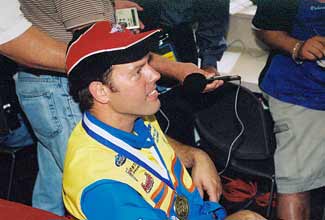 Greg
Anderson wasn’t the star of the class at Chicago, although he advanced
to the finals of the King Demon Crown bonus race for Pro Stock’s elite
eight qualifiers. (Weather problems in Chicago forced his $50,000 showdown with
Dave Connolly to Saturday’s qualifying at Topeka.)
Greg
Anderson wasn’t the star of the class at Chicago, although he advanced
to the finals of the King Demon Crown bonus race for Pro Stock’s elite
eight qualifiers. (Weather problems in Chicago forced his $50,000 showdown with
Dave Connolly to Saturday’s qualifying at Topeka.)
Jason Line, Rookie of the Year candidate and Anderson’s teammate and crew member on the Vegas General Construction team, led the Pro Stock field with a quick time of 6.802 seconds at 202.33 mph in his Pontiac Grand Am.
But Line and Pro Stock Motorcycle’s flashy Gen-Xer Shawn Gann won because their final-round opponents jumped the light.
Gann earned $7,500 for his 7.242-second run at 185.26 mph on his Suzuki against Andrew Hines.
Gann was unaware he had leaped from seventh to second place in the points. “I did? I didn’t know that. That’ll work,” he said. “My season starts are never strong. Anything I get, I get on the back end of the year.”
Hines, the No. 1 qualifier for the third time in four events and winner of the bike season-opener at Gainesville, Fla., in March, maintained his points lead. He also set a track record e.t. of 7.093 seconds on his Screaming Eagle Harley-Davidson in a semifinal victory over Craig Treble.
Hines said that he captured the No. 1 spot by following advice from brother Matt, who won three NHRA bike titles: “Keep your head cool and act like you’re Dale Earnhardt Jr.” But even Little E makes mistakes, and so did Hines. He was 35-hundredths early on the tree against Gann, who cut an .016 light.
Line doubles as dyno specialist on the Grand Am that has carried Anderson to victory in five of the first seven races this year and eight of the previous 10. He also brought to Anderson’s NASCAR shop experience from Joe Gibbs’ operation.
Line earned his first victory in this third final-round meeting with the boss in four races.
Anderson, 42-hundredths of a second too quick off the starting line this time,
had said on several occasions, “I don’t know how long I can hold him
off.”
Line said of his $25,000 win, “I didn’t think I was ever going to
beat him.” He did, with a pass of 6.840 seconds at 202.48 mph.
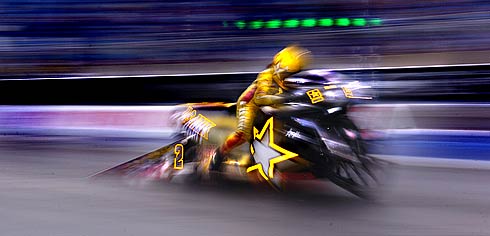
Ron Lewis Photo
![]()
Copyright 1999-2004, Drag acing Online and Racing Net Source